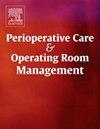局部布比卡因对选择性甲状腺切除术患者全麻苏醒时清醒拔管反应的影响。一项随机对照研究
Q2 Nursing
Perioperative Care and Operating Room Management
Pub Date : 2024-11-27
DOI:10.1016/j.pcorm.2024.100449
引用次数: 0
摘要
顺利拔管的理想组合,即使长时间拔管,和一个简单的操作应用是很难实现的。本研究旨在评估0.5%局部布比卡因在甲状腺切除术患者拔管期间减轻咳嗽、术后喉咙痛和血流动力学波动的疗效。方法48例甲状腺切除术患者随机分为两组,每组24例:C组患者在预期手术结束前,在气管管周围局部给予5 ml 0.9%生理盐水,B组患者在预期手术结束前,在气管管周围局部给予5 ml 0.5%布比卡因,然后人工通气,使气泡分布于整个气道粘膜。主要结局为咳嗽的发生率和程度。次要结果为术后喉咙痛的发生率和程度、拔管时间、拔管过程中血流动力学的变化和副作用。结果与对照组相比,布比卡因组咳嗽的发生率和严重程度均有统计学意义的降低。此外,根据VAS评分评估,布比卡因组术后12小时的喉咙痛严重程度较低。与布比卡因组相比,对照组在拔管期血流动力学参数明显升高,拔管时间和副作用无差异。结论布比卡因在甲状腺切除术患者气管插管前后局部应用,可显著降低围拔管期患者咳嗽和术后咽痛的发生率和严重程度,血流动力学波动较小。本文章由计算机程序翻译,如有差异,请以英文原文为准。
Topical bupivacaine effect on the response to awake extubation during emergence from general anesthesia in patients undergoing elective thyroidectomy. A randomized controlled study
Background
A desirable combination of smooth extubation, even with prolonged extubation, and an easy maneuver to apply is difficult to achieve. This study aimed to evaluate the efficacy of 0.5% topical bupivacaine for reducing cough, postoperative sore throat, and hemodynamic fluctuations during extubation in patients undergoing thyroidectomy.
Methods
Forty-eight patients scheduled for thyroidectomy were randomly assigned to two equal groups (24 each): group (C) patients received 5 ml of 0.9% normal saline topically, and group (B) patients received 5 ml of 0.5% bupivacaine topically 15 min, around the tracheal tube, before the expected end of surgery, followed by manual ventilation to obtain air bubbles distributed throughout the entire airway mucosa. The primary outcomes were the incidence and grade of cough. The secondary outcomes were the incidence and degree of postoperative sore throat, extubation time, hemodynamic changes during extubation, and side effects.
Results
There was a statistically significant decrease in the incidence and the severity of cough in the bupivacaine group compared to the control group. Moreover, the severity of sore throat, as assessed by the VAS score, was lower in the bupivacaine group up to 12 hours postoperatively. The hemodynamic parameters significantly increased in the control group in the peri-extubation period compared to the bupivacaine group, with no difference in extubation time or side effects.
Conclusion
The use of topical bupivacaine around the ETT significantly reduced the incidence and severity of cough and postoperative sore throat with less hemodynamic fluctuations during the periextubation period in patients undergoing thyroidectomy.
求助全文
通过发布文献求助,成功后即可免费获取论文全文。
去求助
来源期刊

Perioperative Care and Operating Room Management
Nursing-Medical and Surgical Nursing
CiteScore
1.30
自引率
0.00%
发文量
52
审稿时长
56 days
期刊介绍:
The objective of this new online journal is to serve as a multidisciplinary, peer-reviewed source of information related to the administrative, economic, operational, safety, and quality aspects of the ambulatory and in-patient operating room and interventional procedural processes. The journal will provide high-quality information and research findings on operational and system-based approaches to ensure safe, coordinated, and high-value periprocedural care. With the current focus on value in health care it is essential that there is a venue for researchers to publish articles on quality improvement process initiatives, process flow modeling, information management, efficient design, cost improvement, use of novel technologies, and management.
 求助内容:
求助内容: 应助结果提醒方式:
应助结果提醒方式:


